第三章上中国八大菜系+外国菜
- 格式:ppt
- 大小:9.57 MB
- 文档页数:82
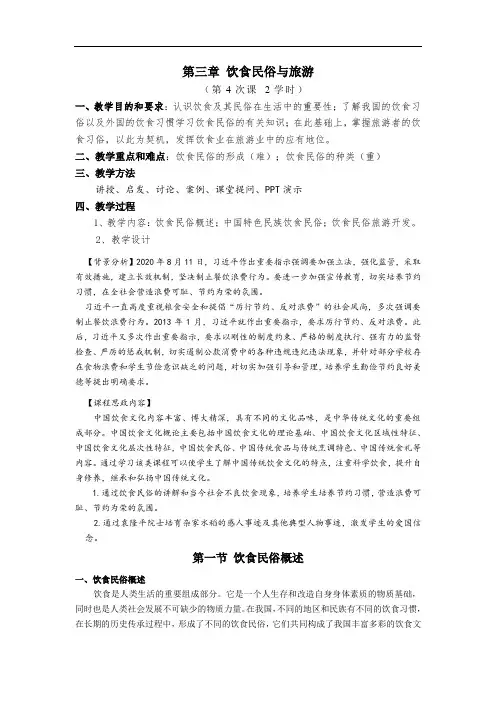
第三章饮食民俗与旅游(第4次课2学时)一、教学目的和要求:认识饮食及其民俗在生活中的重要性;了解我国的饮食习俗以及外国的饮食习惯学习饮食民俗的有关知识;在此基础上,掌握旅游者的饮食习俗,以此为契机,发挥饮食业在旅游业中的应有地位。
二、教学重点和难点:饮食民俗的形成(难);饮食民俗的种类(重)三、教学方法讲授、启发、讨论、案例、课堂提问、PPT演示四、教学过程1、教学内容:饮食民俗概述;中国特色民族饮食民俗;饮食民俗旅游开发。
2、教学设计【背景分析】2020年8月11日,习近平作出重要指示强调要加强立法,强化监管,采取有效措施,建立长效机制,坚决制止餐饮浪费行为。
要进一步加强宣传教育,切实培养节约习惯,在全社会营造浪费可耻、节约为荣的氛围。
习近平一直高度重视粮食安全和提倡“厉行节约、反对浪费”的社会风尚,多次强调要制止餐饮浪费行为。
2013年1月,习近平就作出重要指示,要求厉行节约、反对浪费。
此后,习近平又多次作出重要指示,要求以刚性的制度约束、严格的制度执行、强有力的监督检查、严厉的惩戒机制,切实遏制公款消费中的各种违规违纪违法现象,并针对部分学校存在食物浪费和学生节俭意识缺乏的问题,对切实加强引导和管理,培养学生勤俭节约良好美德等提出明确要求。
【课程思政内容】中国饮食文化内容丰富、博大精深,具有不同的文化品味,是中华传统文化的重要组成部分。
中国饮食文化概论主要包括中国饮食文化的理论基础、中国饮食文化区域性特征、中国饮食文化层次性特征,中国饮食民俗、中国传统食品与传统烹调特色、中国传统食礼等内容。
通过学习该类课程可以使学生了解中国传统饮食文化的特点,注重科学饮食,提升自身修养,继承和弘扬中国传统文化。
1.通过饮食民俗的讲解和当今社会不良饮食现象,培养学生培养节约习惯,营造浪费可耻、节约为荣的氛围。
2.通过袁隆平院士培育杂家水稻的感人事迹及其他典型人物事迹,激发学生的爱国信念。
第一节饮食民俗概述一、饮食民俗概述饮食是人类生活的重要组成部分。
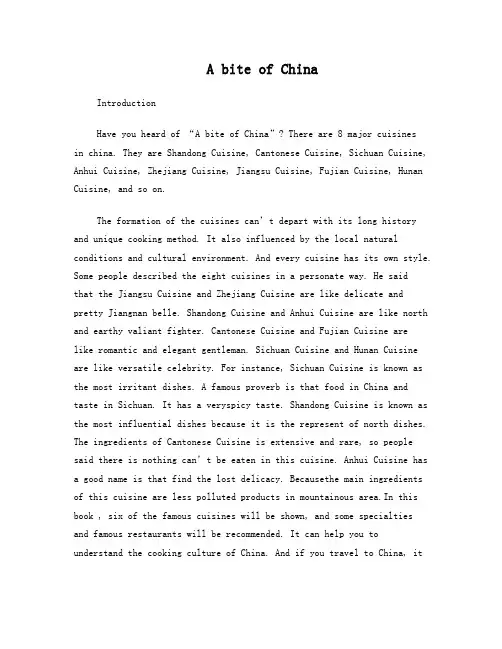
A bite of ChinaIntroductionHave you heard of “A bite of China”? There are 8 major cuisinesin china. They are Shandong Cuisine, Cantonese Cuisine, Sichuan Cuisine, Anhui Cuisine, Zhejiang Cuisine, Jiangsu Cuisine, Fujian Cuisine, Hunan Cuisine, and so on.The formation of the cuisines can’t depart with its long history and unique cooking method. It also influenced by the local natural conditions and cultural environment. And every cuisine has its own style. Some people described the eight cuisines in a personate way. He saidthat the Jiangsu Cuisine and Zhejiang Cuisine are like delicate andpretty Jiangnan belle. Shandong Cuisine and Anhui Cuisine are like north and earthy valiant fighter. Cantonese Cuisine and Fujian Cuisine arelike romantic and elegant gentleman. Sichuan Cuisine and Hunan Cuisine are like versatile celebrity. For instance, Sichuan Cuisine is known as the most irritant dishes. A famous proverb is that food in China and taste in Sichuan. It has a veryspicy taste. Shandong Cuisine is known as the most influential dishes because it is the represent of north dishes. The ingredients of Cantonese Cuisine is extensive and rare, so people said there is nothing can’t be eaten in this cuisine. Anhui Cuisine has a good name is that find the lost delicacy. Becausethe main ingredients of this cuisine are less polluted products in mountainous area.In this book , six of the famous cuisines will be shown, and some specialtiesand famous restaurants will be recommended. It can help you to understand the cooking culture of China. And if you travel to China, itcan help you to choose your favorite food. So you can have a cate enjoyment. Now, let’s open the gate of Chinese Cuisines.Shandong Cuisine (July)Shandong Cuisine, which is originated from Shandong flavor, always clean, pure, and not greasy. Shallot and garlic are two main seasonings of the dishes, so Shandong Cuisine usually tastes pungent. It emphasizes on tenderness, crispness and freshness. Jinan cuisine and jiaonan cuisine are the two main parts of Shandong Cuisine. Jinan cuisine characterizes by deep-frying and stir-frying, grilling, and stir-frying while jiaonan cuisine focuses on cooking food with light taste. Soups are very famous in Shandong Cuisine. If you have a try, you will find that thin soup tastes fresh and creamy soup tastes strong.Shandong is the birthplace of cooking culture, and there ever existed many famous ancient scholars, such as Confucius and Mencius. As old as the ancient scholars, Shandong Cuisine also has a long history. It originated in the Spring and Autumn period , and formed during Qin and Han Dynasty. After Song Dynasty, it became the represent of “the North dishes”. Shandong cuisine is one of the major eight Chinese cuisine and it is the local cuisine that covered most extensive area in China, include Beijing, Tianjin and Dongbei Province.Shandong Province is known as the origination of ancient culture in China. The formation of Shandong Cuisine has a tight connection with the local history, geographical conditions, economic conditions and customs. This province is also known as one of world’s three gardens. For example, jiaozhouChinese cabbage, Zhangqiu garlic, Cangshan shallot are famous in abroad.There are too many Shandong Cuisine restaurants in china. The most famous restaurants includeQilurenjia, Beijing Qilu Restaurant and Tongheju.Cantonese Cuisine(Asiya)Cantonese Cuisine is one of the eight culinary traditions of Chinese cuisine. When westerners speak of Chinese food, they usually refer to Cantonese Cuisine. Why? This is because of the most Chinese who immigrant and set up restaurants overseas were from Guangdong. Now, let me introduce this kind of cuisine. Guangzhou, the capital of Guangdong province, has long been a trading port and many important food. Unlike other Chinese cuisine style of cooking, Cantonese Cuisine more attention to bring out or highlight the original taste of the meet, vegetable. unlike Sichuan Cuisine so spicy, unlike other foods lost original taste of cooking, so Cantonese Cuisine is a little spice or sugar is used generally.Common Cantonese Dishes for you.These dishes are often simple and easy to learn to cook, and they came the most common foods on the menus of Cantonese restaurants.Chinese steamed eggs: there are by beating eggs to a creamy consistency and steaming till this water boiling. Variations are derived by colding different ingredients, such as onion and soy sauce.Noddle dishesShahe noodles are a kind of rice noodles, they are broad and look white, their texture is elastic and like a little chewy. They don’t freeze or drying and should generally purchased fresh in strips that should be cut to the desired width. Shahe noodles are popular in southern china.Meat Dishes.We should boil the chicken in water until the chicken looks golden. When it is cook done, the chicken tastes fresh and maintain original taste of chicken.Seafood.Because Guangdong located on the southern of china, fresh seafoodis easy to available to get and many Cantonese restaurants are best use of this advantages. In Cantonese culinary arts, steaming is best cooking style. According to Cantonese Cuisine, the taste fresh is the most important point, so seafood generally cooked by steaming.Cantonese are known to us that they try different kind of meats and vegetables. So, people those who are in Northern China often says that Cantonese people will eat anything that flies except airplanes, anything that moves on the ground except train, and everything that moves in the water except boats.Panxirestaurant in Guangzhou.Address: 151 west longjin road, Liwan District. Lung king HeenAddress: IFC Tower, 8 Finance st, Hong Kong.Zhejiang cuisine(Clark)Zhejiang cuisine also called ZheCai for short, is one of the eight major cuisines of China. Zhejiang cuisine has it’s unique taste and uniquecooking method. It’s because that Zhejiang province be rich in natural resources. Zhejiang province closed to sea, so Zhejiang cuisine is good at making sea food, and Zhejiang province also is the main place that product meat and rice, so the meat also is the Zhejiang cuisine’s material. So Zhejiang cuisine’s cooking methods mainly are sautéing, stir-frying, simmering and steaming, obtaining the natural flavor and taste. Zhejiang cuisine, not greasy, wins its reputation for freshness, tenderness and smoothness of its dishes with mellow fragrance.Zhejiang cuisines include Hangzhou food, Ningbo food and Shaoxing food. Hangzhou, Ningbo and Shaoxing are all in ZhejiangProvince. Hangzhou food is the most famous cuisine in the Zhejiang cuisine.Hangzhoufood tastes fresh and crisp, and with the change of season it also has different kinds of food. And the main cooking methods of Hangzhou food are sautéing stewing, deep-frying and steaming. Ningbo food is a bit salty but delicious. And Ningbo food is good at steaming,roasting and braising seafood, so Ningbo food famous by retaining original freshness, tenderness and softness. Shaoxing food known asit’s aquatic food and poultry. Sha oxing food has a unique village flavor, smell sweet taste soft and glutinous, thick in gravy and strong in season.Zhejiang cuisine specializes in stir-frying, steaming, deep-frying and simmering, obtaining the natural flavor and taste. And Zhejiang province has full of materials, and people take special care in cooking, so Zhejiang cuisine is so delicious and be famous in China.Anhui Cuisine (Angenla)Anhui cuisine, together with Shan dong cuisine, Sichuan cuisine, Cantonese cuisine, Zhejiang cuisine and Jiangsu cuisine are all belonged to Chinese royal dishes from Qin dynasty. They all pay attention to the cultured colors and fresh materials.It is said that the emperor Yuan collected public opinions from Anhui and Zhejiang provinces when he unified southern China in 221B、C. He happened to be invited to a village when he passes by Anhui province. Although the villagers did not recognize his identify, they treated him with generous hospitality and did him a meal with fresh seafood and home-made chili sauce. When the emperor Yuan came back to the capital, he missed that taste and the people there. To memorize villagers’ kindness and this moved experience, he named it Hui cuisine and listed Anhui cuisine as one of the eight major components of Chinese cuisine.The most famous dish of Anhui cuisine called “Boiled fish”. They put the raw fish into boiled chili oil and add green onion, ginger, garlic and soy to it. Wait your raw ingredients are slow-cooked in a safe, enclosed cooker for 20minutes and a delicious boiled fish is born!Have a taste, you can feel the fish with hot sauce is melted in your mouth.Southern cuisines like to use seafood and chilies to make the foods have strong taste. Similarly,traditional Anhui cuisine as a part of southern cuisine also use fierce ingredients to awakening thegastricfire .On completely contrast, northern cuisine ,like Shandong cuisine are light and use chilies and pepper as less as they can.However, because of the big differences between southern cuisines and northern cuisines, Chinese dietary culture appears to be rich and varied.Jiangsu Cuisine(Belle)Jiangsu cuisine, which is abbreviated to su cuisine, is one of the eight cuisines of Chinese mainly nationality. It was invented two thousand years ago. Jiangsu cuisine is similar to the Zhejiang cuisine. They are both also called the land of fish and rice because of the much water there. Jiangsu province and Zhejiang province are located in the south of China and beside the sea, so there are a lot of rainfall in Jiangsu and Zhejiang. Therefore, some delicious food is made of fish in Jiangsu and Zhejiang province. On the other hand, Jiangsu cuisine is different from Zhejiang and the other places. Its characteristic is thick with light, crisp and fresh juice broth strong but not greasy, gentle, salty and sweet. The cookers in Jiangsu are good at stewing, braising, burning, heating and frying. In addition, they are skilled in cooking soup that taste very fresh. What is the most representative are Suzhou dish, Yangzhou dish, Nanjing dish and Zhenjiang dish. Suzhoufood taste sweet and its color slants harmony. Yangzhou cuisine haslight material, fine mellow flavor and knife labor. Nanjing and Zhejiang dish focus on alcohol which make the dishes have exquisite dainty, especially in the prestigious duck dishes. In a word, Jiangsu cuisine is famous for its colorful selection of ingredients, its meticulous preparation methodology and its not-too- bland taste.。
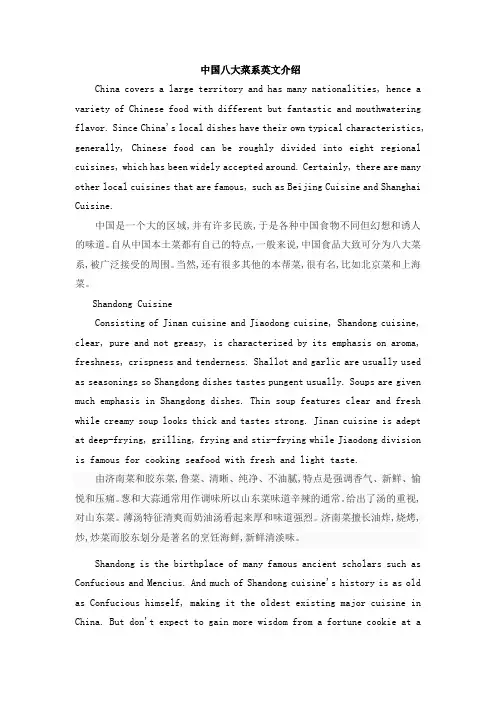
中国八大菜系英文介绍China covers a large territory and has many nationalities, hence a variety of Chinese food with different but fantastic and mouthwatering flavor. Since China's local dishes have their own typical characteristics, generally, Chinese food can be roughly divided into eight regional cuisines, which has been widely accepted around. Certainly, there are many other local cuisines that are famous, such as Beijing Cuisine and Shanghai Cuisine.中国是一个大的区域,并有许多民族,于是各种中国食物不同但幻想和诱人的味道。
自从中国本土菜都有自己的特点,一般来说,中国食品大致可分为八大菜系,被广泛接受的周围。
当然,还有很多其他的本帮菜,很有名,比如北京菜和上海菜。
Shandong CuisineConsisting of Jinan cuisine and Jiaodong cuisine, Shandong cuisine, clear, pure and not greasy, is characterized by its emphasis on aroma, freshness, crispness and tenderness. Shallot and garlic are usually used as seasonings so Shangdong dishes tastes pungent usually. Soups are given much emphasis in Shangdong dishes. Thin soup features clear and fresh while creamy soup looks thick and tastes strong. Jinan cuisine is adept at deep-frying, grilling, frying and stir-frying while Jiaodong division is famous for cooking seafood with fresh and light taste.由济南菜和胶东菜,鲁菜、清晰、纯净、不油腻,特点是强调香气、新鲜、愉悦和压痛。
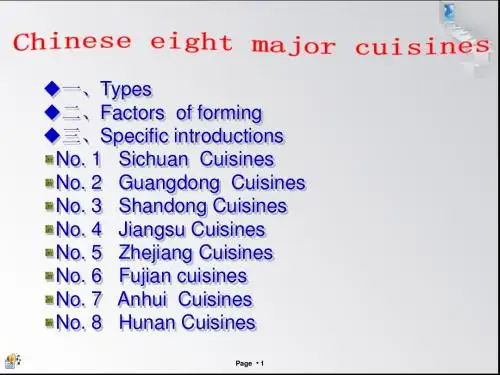
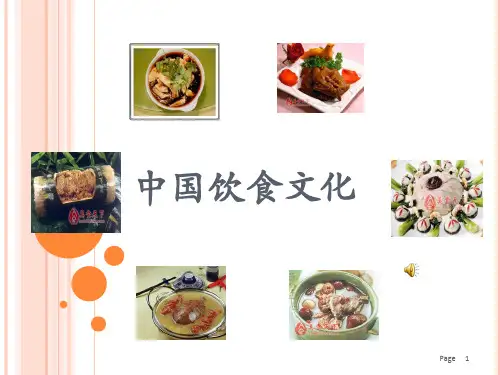
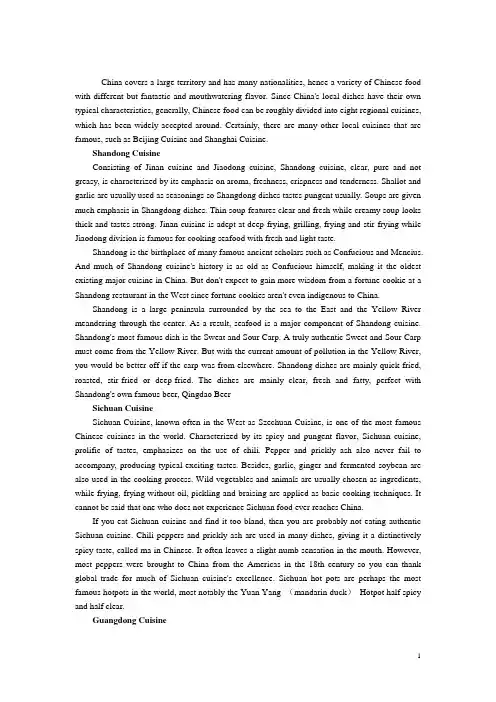
China covers a large territory and has many nationalities, hence a variety of Chinese food with different but fantastic and mouthwatering flavor. Since China's local dishes have their own typical characteristics, generally, Chinese food can be roughly divided into eight regional cuisines, which has been widely accepted around. Certainly, there are many other local cuisines that are famous, such as Beijing Cuisine and Shanghai Cuisine.Shandong CuisineConsisting of Jinan cuisine and Jiaodong cuisine, Shandong cuisine, clear, pure and not greasy, is characterized by its emphasis on aroma, freshness, crispness and tenderness. Shallot and garlic are usually used as seasonings so Shangdong dishes tastes pungent usually. Soups are given much emphasis in Shangdong dishes. Thin soup features clear and fresh while creamy soup looks thick and tastes strong. Jinan cuisine is adept at deep-frying, grilling, frying and stir-frying while Jiaodong division is famous for cooking seafood with fresh and light taste.Shandong is the birthplace of many famous ancient scholars such as Confucious and Mencius. And much of Shandong cuisine's history is as old as Confucious himself, making it the oldest existing major cuisine in China. But don't expect to gain more wisdom from a fortune cookie at a Shandong restaurant in the West since fortune cookies aren't even indigenous to China.Shandong is a large peninsula surrounded by the sea to the East and the Yellow River meandering through the center. As a result, seafood is a major component of Shandong cuisine. Shandong's most famous dish is the Sweat and Sour Carp. A truly authentic Sweet and Sour Carp must come from the Yellow River. But with the current amount of pollution in the Yellow River, you would be better off if the carp was from elsewhere. Shandong dishes are mainly quick-fried, roasted, stir-fried or deep-fried. The dishes are mainly clear, fresh and fatty, perfect with Shandong's own famous beer, Qingdao BeerSichuan CuisineSichuan Cuisine, known often in the West as Szechuan Cuisine, is one of the most famous Chinese cuisines in the world. Characterized by its spicy and pungent flavor, Sichuan cuisine, prolific of tastes, emphasizes on the use of chili. Pepper and prickly ash also never fail to accompany, producing typical exciting tastes. Besides, garlic, ginger and fermented soybean are also used in the cooking process. Wild vegetables and animals are usually chosen as ingredients, while frying, frying without oil, pickling and braising are applied as basic cooking techniques. It cannot be said that one who does not experience Sichuan food ever reaches China.If you eat Sichuan cuisine and find it too bland, then you are probably not eating authentic Sichuan cuisine. Chili peppers and prickly ash are used in many dishes, giving it a distinctively spicy taste, called ma in Chinese. It often leaves a slight numb sensation in the mouth. However, most peppers were brought to China from the Americas in the 18th century so you can thank global trade for much of Sichuan cuisine's excellence. Sichuan hot pots are perhaps the most famous hotpots in the world, most notably the Yuan Yang (mandarin duck)Hotpot half spicy and half clear.Guangdong CuisineCantonese food originates from Guangdong, the southernmost province in China. The majority of overseas Chinese people are from Guangdong (Canton)so Cantonese is perhaps the most widely available Chinese regional cuisine outside of China.Cantonese are known to have an adventurous palate, able to eat many different kinds of meats and vegetables. In fact, people in Northern China often say that Cantonese people will eat anything that flies except airplanes, anything that moves on the ground except trains, and anything that moves in the water except boats. This statement is far from the truth, but Cantonese food is easily one of the most diverse and richest cuisines in China. Many vegetables originate from other parts of the world. It doesn't use much spice, bringing out the natural flavor of the vegetables and meats.Tasting clear, light, crisp and fresh, Guangdong cuisine, familiar to Westerners, usually chooses raptors and beasts to produce originative dishes. Its basic cooking techniques include roasting, stir-frying, sauteing, deep-frying, braising, stewing and steaming. Among them steaming and stir-frying are more commonly applied to preserve the natural flavor. Guangdong chefs also pay much attention to the artistic presentation of dishes.Fujian CuisineConsisting of Fuzhou Cuisine, Quanzhou Cuisine and Xiamen Cuisine, Fujian Cuisine is distinguished for its choice seafood, beautiful color and magic taste of sweet, sour, salty and savory. The most distinct features are their "pickled taste".Jiangsu CuisineJiangsu Cuisine, also called Huaiyang Cuisine, is popular in the lower reach of the Yangtze River. Aquatics as the main ingredients, it stresses the freshness of materials. Its carving techniques are delicate, of which the melon carving technique is especially well known. Cooking techniques consist of stewing, braising, roasting, simmering, etc. The flavor of Huaiyang Cuisine is light, fresh and sweet and with delicate elegance. Jiangsu cuisine is well known for its careful selection of ingredients, its meticulous preparation methodology, and its not-too-spicy, not-too-bland taste. Since the seasons vary in climate considerably in Jiangsu, the cuisine also varies throughout the year. If the flavor is strong, it isn't too heavy; if light, not too bland.Zhejiang CuisineComprising local cuisines of Hangzhou, Ningbo and Shaoxing, Zhejiang Cuisine, not greasy, wins its reputation for freshness, tenderness, softness, smoothness of its dishes with mellow fragrance. Hangzhou Cuisine is the most famous one among the three.Hunan cuisineHunan cuisine consists of local Cuisines of Xiangjiang Region, Dongting Lake and Xiangxi coteau. It characterizes itself by thick and pungent flavor. Chili, pepper and shallot are usually necessaries in this division.Anhui CuisineAnhui Cuisine chefs focus much more attention on the temperature in cooking and are good at braising and stewing. Often hams will be added to improve taste and sugar candy added to gain。
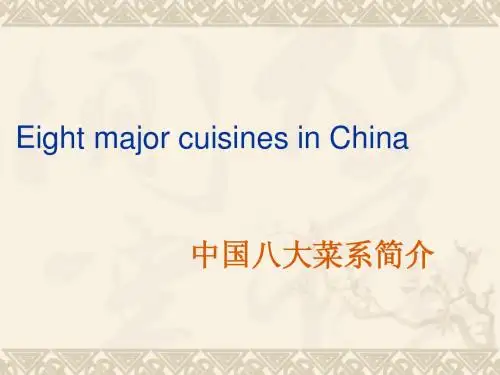
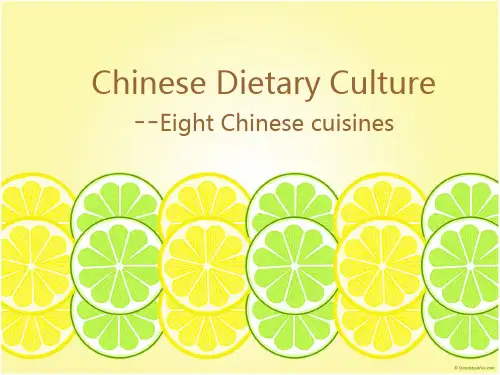
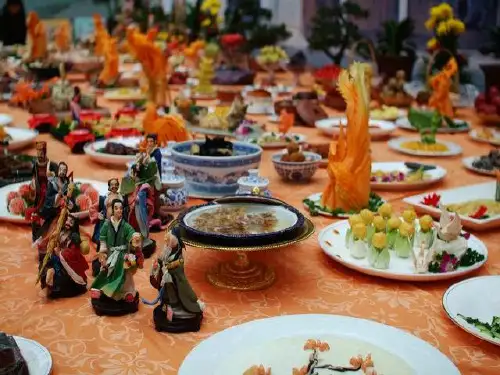
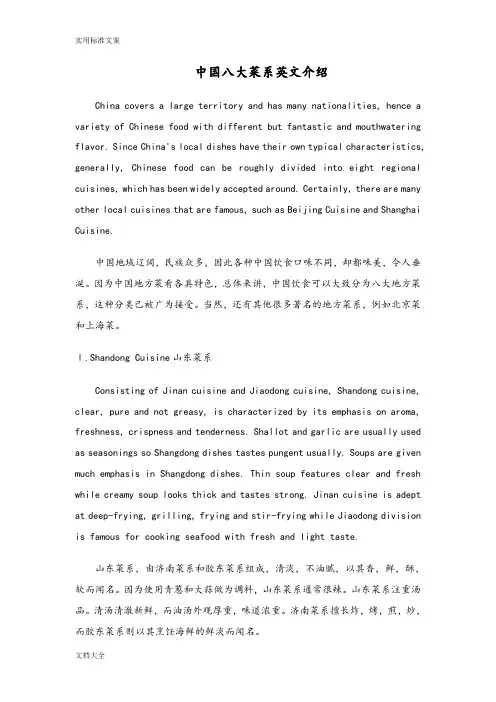
中国八大菜系英文介绍China covers a large territory and has many nationalities, hence a variety of Chinese food with different but fantastic and mouthwatering flavor. Since China's local dishes have their own typical characteristics, generally, Chinese food can be roughly divided into eight regional cuisines, which has been widely accepted around. Certainly, there are many other local cuisines that are famous, such as Beijing Cuisine and Shanghai Cuisine.中国地域辽阔,民族众多,因此各种中国饮食口味不同,却都味美,令人垂涎。
因为中国地方菜肴各具特色,总体来讲,中国饮食可以大致分为八大地方菜系,这种分类已被广为接受。
当然,还有其他很多著名的地方菜系,例如北京菜和上海菜。
Ⅰ.Shandong Cuisine山东菜系Consisting of Jinan cuisine and Jiaodong cuisine, Shandong cuisine, clear, pure and not greasy, is characterized by its emphasis on aroma, freshness, crispness and tenderness. Shallot and garlic are usually used as seasonings so Shangdong dishes tastes pungent usually. Soups are given much emphasis in Shangdong dishes. Thin soup features clear and fresh while creamy soup looks thick and tastes strong. Jinan cuisine is adept at deep-frying, grilling, frying and stir-frying while Jiaodong division is famous for cooking seafood with fresh and light taste.山东菜系,由济南菜系和胶东菜系组成,清淡,不油腻,以其香,鲜,酥,软而闻名。
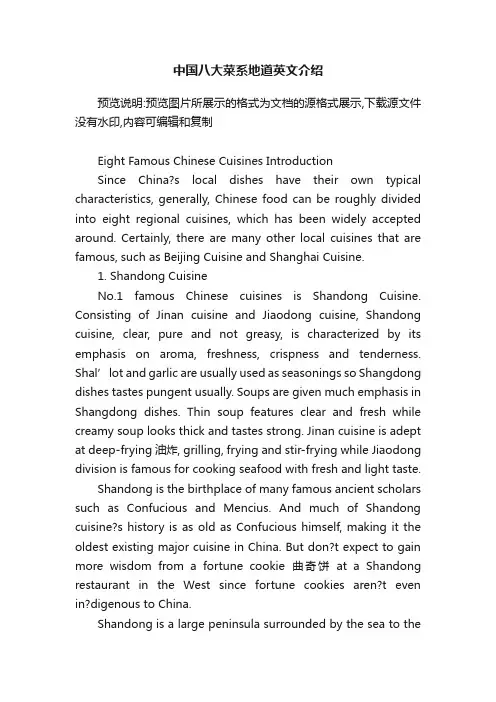
中国八大菜系地道英文介绍预览说明:预览图片所展示的格式为文档的源格式展示,下载源文件没有水印,内容可编辑和复制Eight Famous Chinese Cuisines IntroductionSince China?s local dishes have their own typical characteristics, generally, Chinese food can be roughly divided into eight regional cuisines, which has been widely accepted around. Certainly, there are many other local cuisines that are famous, such as Beijing Cuisine and Shanghai Cuisine.1. Shandong CuisineNo.1 famous Chinese cuisines is Shandong Cuisine. Consisting of Jinan cuisine and Jiaodong cuisine, Shandong cuisine, clear, pure and not greasy, is characterized by its emphasis on aroma, freshness, crispness and tenderness. Shal’lot and garlic are usually used as seasonings so Shangdong dishes tastes pungent usually. Soups are given much emphasis in Shangdong dishes. Thin soup features clear and fresh while creamy soup looks thick and tastes strong. Jinan cuisine is adept at deep-frying油炸, grilling, frying and stir-frying while Jiaodong division is famous for cooking seafood with fresh and light taste.Shandong is the birthplace of many famous ancient scholars such as Confucious and Mencius. And much of Shandong cuisine?s history is as old as Confucious himself, making it the oldest existing major cuisine in China. But don?t expect to gain more wisdom from a fortune cookie曲奇饼at a Shandong restaurant in the West since fortune cookies aren?t even in?digenous to China.Shandong is a large peninsula surrounded by the sea to theEast and the Yellow River meander ing through the center. As a result, seafood is a major component of Shandong cuisine. Shandong?s most famous dish is the Sweat and Sour Carp糖醋鲤鱼. A truly authentic Sweet and Sour Carp must come from the Yellow River. But with the current amount of pollution in the Yellow River, you would be better off if the carp was from elsewhere. Shandong dishes are mainly quick-fried, roasted, stir-fried or deep-fried. The dishes are mainly clear, fresh and fatty, perfect with Shandong?s own famous beer, Qingdao Beer.2. Sichuan CuisineNo.2 famous Chinese cuisines is Sichuan Cuisine. Sichuan Cuisine, known often in the West as Szechuan Cuisine, is one of the most famous Chinese cuisines in the world. Characterized by its spicy and pungen t flavor, Sichuan cuisine, pro’lific of tastes 口感丰厚, emphasizes on the use of chili. Pepper and prickly ash also never fail to accompany, producing typical exciting tastes. Besides, garlic, ginger and fermented soybean are also used in the cooking process. Wild vegetables and animals are usually chosen as ingredients, while frying, frying without oil, pickling and braising are applied as basic cooking techniques. It cannot be said that one who does not experience Sichuan food ever reaches China.If you eat Sichuan cuisine and find it too bland, then you are probably not eating authentic Sichuan cuisine. Chili peppers and prickly ash are used in many dishes, giving it a distinctively spicy taste, called ma in Chinese. It often leaves a slight numb sensation in the mouth. However, most peppers were brought to China from the Americas in the 18th century so you can thank global trade for much of Sichuan cuisine?s excellence. Sichuanhot pot s are perhaps the most famous hotpots in the world, most notably the Yuan Yang (mandarin duck)Hotpot half spicy and half clear.3. Guangdong CuisineNo.3 famous Chinese cuisines is Guangdong Cuisine. Cantonese food originates from Guangdong, the southernmost province in China. The majority of overseas Chinese people are from Guangdong (Canton) so Cantonese is perhaps the most widely available Chinese regional cuisine outside of China.Cantonese are known to have an adventurous …palate, able to eat many different kinds of meats and vegetables. In fact, people in Northern China often say that Cantonese people will eat anything that flies except airplanes, anything that moves on the ground except trains, and anything that moves in the water except boats. This statement is far from the truth, but Cantonese food is easily one of the most diverse and richest cuisines in China. Many vegetables originate from other parts of the world. It doesn?t use much spice调料, bringing out the natural flavor of the vegetables and meats.Tasting clear, light, crisp and fresh, Guangdong cuisine, familiar to Westerners, usually chooses raptors and beasts to produce originative dishes. Its basic cooking techniques include roasting, stir-frying, saute ing, deep-frying, braising, stewing and steaming. Among them steaming and stir-frying are more commonly applied to preserve the natural flavor. Guangdong chefs also pay much attention to the artistic presentation of dishes.4.Fujian CuisineNo.4 famous Chinese cuisines is Fujian Cuisine. Consisting ofFuzhou Cuisine, Quanzhou Cuisine and Xiamen Cuisine, Fujian Cuisine is distinguished for its choice seafood, beautiful color and magic taste of sweet, sour, salty and savory. The most distinct features are their “pickled taste”.5. Jiangsu CuisineNo.5 famous Chinese cuisines is Jiangsu Cuisine. Jiangsu Cuisine, also called Huaiyang Cuisine, is popular in the lower reach of the Yangtze River. Aquatic s as the main ingredients, it stresses the freshness of materials. Its carving techniques are delicate, of which the melon carving technique is especially well known. Cooking techniques consist of stewing, braising, roasting, simmering, etc. The flavor of Huaiyang Cuisine is light, fresh and sweet and with delicate elegance. Jiangsu cuisine is well known for its careful selection of ingredients, its me?ticulous preparation methodology, and its not-too-spicy, not-too-bland taste. Since the seasons vary in climate considerably in Jiangsu, the cuisine also varies throughout the year. If the flavor is strong, it isn?t too heavy; if light, not too bland.6. Zhejiang CuisineNo.6famous Chinese cuisines is Zhejiang Cuisine. Comprising local cuisines of Hangzhou, Ningbo and Shaoxing, Zhejiang Cuisine, not greasy, wins its reputation for freshness, tenderness, softness, smoothness of its dishes with mellow fragrance. Hangzhou Cuisine is the most famous one among the three.7. Hunan cuisineNo.7 famous Chinese cuisines is Hunan cuisinee. Hunan cuisine consists of local Cuisines of Xiangjiang Region, Dongting Lake and Xiangxi coteau. It characterizes itself by thick andpungent flavor. Chili, pepper and shallot are usually necessaries in this division.8. Anhui CuisineNo.8 famous Chinese cuisines is Anhui Cuisine. Anhui Cuisine chefs focus much more attention on the temperature in cooking and are good at braising and stewing. Often hams will be added to improve taste and sugar candy added to gain...。